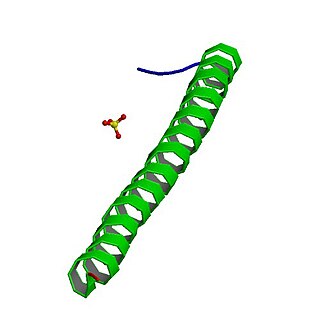Microtubule-associated protein RP/EB family member 1 is a protein that in humans is encoded by the MAPRE1 gene. [5] [6] [7] [8]
Microtubule-associated protein RP/EB family member 1 is a protein that in humans is encoded by the MAPRE1 gene. [5] [6] [7] [8]
The protein encoded by this gene was first identified by its binding to the APC (Adenomatous polyposis coli) protein which is often mutated in familial and sporadic forms of colorectal cancer. [9]
Immunofluorescence has demonstrated that EB1 localizes to the centrosome, mitotic spindle, and distal tips of cytoplasmic microtubules. Throughout the cell cycle, EB1 proteins situate on the microtubule plus ends, which is why EB1 is categorized as a microtubule plus end tracking protein(+TIP protein). [10]
The protein also associates with components of the dynactin complex and the intermediate chain of cytoplasmic dynein. Because of these associations, it is thought that this protein is involved in the regulation of microtubule structures and chromosome stability. This gene is a member of the RP/EB family. [8]

Dyneins are a family of cytoskeletal motor proteins that move along microtubules in cells. They convert the chemical energy stored in ATP to mechanical work. Dynein transports various cellular cargos, provides forces and displacements important in mitosis, and drives the beat of eukaryotic cilia and flagella. All of these functions rely on dynein's ability to move towards the minus-end of the microtubules, known as retrograde transport; thus, they are called "minus-end directed motors". In contrast, most kinesin motor proteins move toward the microtubules' plus-end, in what is called anterograde transport.

Adenomatous polyposis coli (APC) also known as deleted in polyposis 2.5 (DP2.5) is a protein that in humans is encoded by the APC gene. The APC protein is a negative regulator that controls beta-catenin concentrations and interacts with E-cadherin, which are involved in cell adhesion. Mutations in the APC gene may result in colorectal cancer.

Dynactin subunit 1 is a protein that in humans is encoded by the DCTN1 gene.

Dynactin is a 23 subunit protein complex that acts as a co-factor for the microtubule motor cytoplasmic dynein-1. It is built around a short filament of actin related protein-1 (Arp1).

Telomeric repeat-binding factor 1 is a protein that in humans is encoded by the TERF1 gene.

Mitotic spindle assembly checkpoint protein MAD2A is a protein that in humans is encoded by the MAD2L1 gene.

CAP-GLY domain containing linker protein 1, also known as CLIP1, is a protein which in humans is encoded by the CLIP1 gene.

Dynactin subunit 2 is a protein that in humans is encoded by the DCTN2 gene

Kinesin-like protein KIF23 is a protein that in humans is encoded by the KIF23 gene.

Alpha-centractin (yeast) or ARP1 is a protein that in humans is encoded by the ACTR1A gene.

Microtubule-associated protein RP/EB family member 2 is a protein that in humans is encoded by the MAPRE2 gene.

Targeting protein for Xklp2 is a protein that in humans is encoded by the TPX2 gene. It is one of the many spindle assembly factors that play a key role in inducing microtubule assembly and growth during M phase.

Microtubule-actin cross-linking factor 1, isoforms 1/2/3/5 is a protein that in humans is encoded by the MACF1 gene.

Mitotic checkpoint protein BUB3 is a protein that in humans is encoded by the BUB3 gene.

Protein Regulator of cytokinesis 1 (PRC1) is a protein that in humans is encoded by the PRC1 gene and is involved in cytokinesis.

Microtubule-associated protein RP/EB family member 3 is a protein that in humans is encoded by the MAPRE3 gene.

Mad1 is a non-essential protein which in yeast has a function in the spindle assembly checkpoint (SAC). This checkpoint monitors chromosome attachment to spindle microtubules and prevents cells from starting anaphase until the spindle is built up. The name Mad refers to the observation that mutant cells are mitotic arrest deficient (MAD) during microtubule depolymerization. Mad1 recruits the anaphase inhibitor Mad2 to unattached kinetochores and is essential for Mad2-Cdc20 complex formation in vivo but not in vitro. In vivo, Mad1 acts as a competitive inhibitor of the Mad2-Cdc20 complex. Mad1 is phosphorylated by Mps1 which then leads together with other activities to the formation of the mitotic checkpoint complex (MCC). Thereby it inhibits the activity of the anaphase-promoting complex/cyclosome (APC/C). Homologues of Mad1 are conserved in eukaryotes from yeast to mammals.

Centrosomal protein of 192 kDa, also known as Cep192, is a protein that in humans is encoded by the CEP192 gene. It is the homolog of the C. elegans and D. melanogaster gene SPD-2.

Phosphoinositide 3-kinase regulatory subunit 4, also known as PI3-kinase regulatory subunit 4 or PI3-kinase p150 subunit or phosphoinositide 3-kinase adaptor protein, or VPS15 is an enzyme that in humans is encoded by the PIK3R4 gene.
Microtubule plus-end/positive-end tracking proteins or +TIPs are a type of microtubule associated protein (MAP) which accumulate at the plus ends of microtubules. +TIPs are arranged in diverse groups which are classified based on their structural components; however, all classifications are distinguished by their specific accumulation at the plus end of microtubules and their ability to maintain interactions between themselves and other +TIPs regardless of type. +TIPs can be either membrane bound or cytoplasmic, depending on the type of +TIPs. Most +TIPs track the ends of extending microtubules in a non-autonomous manner.